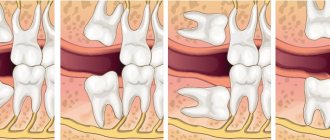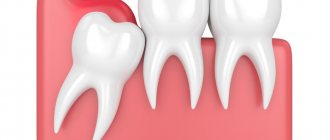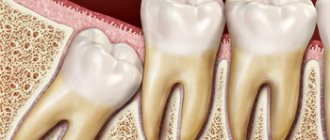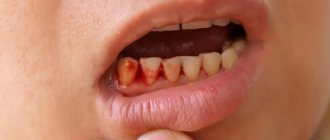Wisdom or 8 teeth can cause a lot of problems, especially if they grow into the cheek. These teeth have no analogues in the primary occlusion, so they erupt through unprepared periodontal tissue, and their growth is accompanied by discomfort even with proper eruption. The growth of eighth teeth can begin at age 17, but there are cases when these teeth remain impacted (not erupted) throughout life.
Symptoms and signs of abnormal growth
It is extremely rare for eights to appear without any complications. This is due, first of all, to the fact that wisdom teeth grow in adulthood, when the jaw is already formed. Even with proper teething, discomfort may still be present for several weeks or months. If a wisdom tooth grows incorrectly or has an abnormal location, then certain symptoms indicate this.
Let's take a closer look at the types of pathologies and symptoms associated with the growth of wisdom teeth.
- Retention is a pathology in which the third molar is located under the mucous or bone tissue. The main symptoms are severe pain in the gums, as well as the development of an inflammatory process in the gum pocket.
- Dystopia or abnormal position of the tooth. It manifests itself as severe pain, affecting adjacent teeth, and the development of inflammation, including phlegmon or osteomyelitis.
The initial alarming symptoms that a patient may identify when a wisdom tooth grows are:
- Swelling in the cheek area.
- When swallowing, severe pain occurs, radiating to the throat or ear.
- Purulent or bloody discharge.
- Injury to the mucous membrane.
If you detect at least one of the above symptoms during the eruption of figure eights, you must seek the help of a dentist as soon as possible. The doctor will conduct an x-ray and determine whether the wisdom tooth is growing correctly.
Other causes of pain during the eruption of wisdom teeth
Only in rare cases do eights erupt without problems, but more often this happens for a long time and painfully. Severe pain also appears if:
- the tooth is cut through already formed bone;
- growth does not occur upward, but to the side at an angle, while it rests on adjacent teeth or jawbone;
- there is not enough space in the mouth for a figure eight to fully grow;
- inflammation began in the soft tissues around the tooth;
- an infection has entered the canal;
- the presence of a carious cavity in the figure eight, which often grows very slowly.
What to do with a bothersome wisdom tooth at home
The most important thing is not to cause further harm to yourself before visiting the dentist. It is extremely important to avoid overheating the area of concern. Heat can accelerate the onset of the inflammatory process. Therefore, you should not apply warm compresses or take a hot bath.
What can you do to relieve pain when wisdom teeth erupt:
- follow a gentle diet (do not eat very hard, hot or cold foods);
- after eating, rinse your mouth;
- use local anesthesia, such as gels used during teething in children;
- In case of severe pain, you can take painkillers.
But the most important thing is not to delay your visit to a specialist! Only he will be able to determine the seriousness of the problem and help avoid possible complications.
Stages of wisdom tooth growth
The first rudiments of eights can appear in the jaw as early as 6 years of age, when baby teeth begin to be replaced by permanent teeth. By this age, the bone tissue is almost completely formed, and molars appear. However, due to the absence of an embryo in the primary occlusion, the figure eight is forced to make its way on its own, and as a result, it may take a not entirely favorable place.
The average age of appearance of the third molar is approximately 19-25 years, but in many patients it does not appear until after 35 years of age. Unfortunately, there is no exact answer to the question of age; everything will depend on individual hormonal characteristics, genetic predisposition and the shape of a person’s jaw.
Unfortunately, the later this process begins, the more often the patient encounters complications. Approximately 10% of the population does not have the rudiments of these teeth at all; this can be definitively confirmed by the results of an X-ray examination. It can be carried out after 25 years, if the wisdom tooth has not appeared by this time.
Removal of abnormally growing eighth tooth
Very often, if the third molar grows abnormally, it is necessary to resort to its removal. Indications for surgery:
- Repeated cases of pericoronitis (purulent formation in the gum pocket). This problem most often occurs on the lower eights, which have not completely erupted. Pericoronitis is usually treated by removing the overhanging gum, but if the disease recurs, it is recommended to remove the offending tooth.
- The upper eight grows into the cheek, constantly injuring it. To avoid the formation of ulcers and infection of the oral cavity, as well as to prevent pain, wisdom tooth removal is required.
- The development of wisdom tooth dystopia was diagnosed. The tooth grows at an incorrect angle, which can lead to inflammation of the periodontal tissues and the development of caries on the eighth and neighboring teeth.
- The wisdom tooth grows to the side and affects the ternary nerve, causing attacks of pain. Most often, this occurs when an unerupted figure eight rests on the roots of neighboring teeth. Such an anomaly can only be diagnosed using an x-ray.
The procedure for performing the manipulation may differ depending on the location of the tooth. The sequence of the procedure during surgery:
- antiseptic treatment of the operating area;
- administration of anesthetic;
- tooth extraction;
- inserting a gauze swab into the hole to eliminate bleeding.
The tampon should be removed from the wound no earlier than after 25 minutes. The tampon must be in the socket to prevent bleeding. After the operation, the dental surgeon gives recommendations that must be strictly followed.
Duration of cutting through eights
Many patients are interested in how long it takes for wisdom teeth to erupt. There is also no clear and unambiguous answer to this question. For some, this process takes only a few months, while for others it takes several years. Even the patient’s diet and immunity can influence the duration.
Quite often, cutting through the passage takes place in several stages, so it seems longer. That is, the process begins, and then slows down a little, after which it starts again. However, it is worth considering the reasons why a wisdom tooth may not erupt at all.
These reasons include the presence of supernumerary teeth in a row, hereditary predisposition and the special structure of the jaw bone, a diet that is not rich enough in beneficial vitamins and minerals for the active growth of the figure eight, severe injuries to baby teeth, as well as all kinds of inflammation and infections.
Is it possible to straighten crooked teeth as an adult?
Dentistry today offers many ways to correct malocclusion in adults. When a person, year after year, day after day, sees in the reflection a smile with uneven teeth, it will be very interesting for him to look at the prospect, to see how his smile will look with a corrected bite. It will be interesting to know how this will affect the external image. Finding out this became possible with the 3D virtual setup technique, when the patient can see the step-by-step change in the position of his teeth.
The technique of correcting a bite with aligners involves preliminary drawing up a virtual treatment plan. The dentist takes photographs of the patient: his face, teeth. X-rays and dental impressions are taken. The data is processed by a computer program, resulting in a three-dimensional model in which the simulated dentofacial system is visible from all sides.
The orthodontist has been trained in imaging software and can create a treatment plan by moving the curved units along the desired path to create an even row on the arch. The computer calculates the duration of treatment until the desired result is achieved, as well as the required number of droppers for therapy. The technique is almost 100% accurate. Computer modeling is programmed in such a way as to calculate all stages of change on the path to correcting the pathology.
Symptoms
Third molars are the medical name for wisdom teeth. And there is no need to talk about the natural pathology of the third molars before they begin to erupt. But it is worth paying close attention to the first signs that appear as the unit grows. What you should be wary of:
- bleeding at the end of the dentition, increasing with chewing loads or mechanical cleaning;
- inflammation of the soft tissues in the area of the erupted second molar, where the next one is expected to appear;
- increased pain when chewing and swallowing, pain symptoms do not go away over time, but only increase;
- swelling of the gums is observed, sometimes surrounding organs are also involved in the process;
- In the growth zone of the third molar, the inner surface of the cheek is injured;
- a painful lump is felt;
- I periodically experience intense headaches, fever, and general malaise.
The wisdom tooth does not grow quickly, which means that the described symptoms bother you from time to time over a long period. Some people suffer like this for years. And of course nothing goes away until a person consults a doctor.
There are several reasons for crooked teeth in adults:
- Genetic factor
. The influence of genetics cannot be undone. If the parents had crooked teeth, there is a high chance that the child will face the same problem.
- Jaw development occurs incorrectly.
They may be underdeveloped and there will not be enough space for all the teeth in a row. Poor nutrition from childhood and the use of pacifiers in a baby affect the condition of the dental system.
- Premature loss of baby teeth.
If a child’s tooth in an unstable bite is pulled out before it falls out on its own, this affects the correct growth of the permanent one. In place of the removed milk, an empty space is formed, and neighboring units begin to shift towards the defect. The space for a permanent tooth is reduced, while the chance for an uneven permanent bite increases. The same reason is relevant for adults when a tooth is removed. Under chewing load, the adjacent permanent teeth begin to shift towards the defect, and on the opposite side they increase in height. The bite deteriorates, even if it was smooth before.
- Insufficient attention of parents to the state of the oral cavity of children during a change in bite.
Milk teeth may not be replaced by permanent ones for a long time, or they may not fall out, but the permanent ones have already erupted. A picture of a double row of teeth appears. Even if the milk units are removed at this point, the permanent ones require orthodontic treatment.
- Eruption of wisdom teeth.
Eights often grow crookedly due to an underdeveloped jaw. If there is not enough space for cutting, the rest will move, forming an uneven row. If the patient had no problems with a beautiful smile before the appearance of eights, then the eruption of wisdom teeth may lead to the need for orthodontic intervention.
- Parallel somatic diseases of the ENT organs.
In acute or chronic course of the disease, bone tissue may become deformed. Because of this, the bite deteriorates. In childhood, abnormal growth of glandular tissue – adenoids – is common. If the disease is not treated, the child develops non-physiological mouth breathing, leading to serious consequences.
- Parafunction of language
– excessive (outside of swallowing or physiological functions) stereotypical repetition of tongue movements. Normally, the tongue is involved in speech, swallowing, and chewing food. In this case, the tongue is in a certain position. If this position is disturbed, the tongue pushes out the teeth, putting constant pressure on them, which bends them.It is possible to correct such a defect in collaboration with speech therapists. The orthodontist corrects the bite, the speech therapist helps muscle memory with exercises to consolidate the physiologically correct position of the tongue. If this is not done, then even if the bite is corrected, the pressure of the tongue will return the bite pathology back.
- Poor posture is a malocclusion.
A cause-and-effect factor that acts in both directions. Crooked teeth cause problems with the spine. Impaired functioning of the maxillofacial muscles can be caused by an incorrectly placed filling, crooked teeth, or incorrect jaw position. This affects the condition of the spine, the occurrence of pain in the neck, lower back, and thoracic region.An incorrect bite indirectly causes headaches, pain in the legs, and a protruded stomach that is difficult to retract. All of the above is also true in the opposite direction. If there are problems with posture, its violation, this will affect the functioning of the jaws and will manifest itself in an incorrect bite. This problem can be corrected in collaboration with an osteopath.
When tissue grows, the child cannot breathe normally with his mouth closed. This is the cause of narrowing and underdevelopment of the upper jaws. The consequence of this is uneven teeth, an incorrect bite with an abnormal jaw relationship. The upper jaw lags behind in development, but the lower jaw continues to grow.
In adulthood, a person strives to look 100%, and the beauty of a smile is an important part of image and health. There is a desire to figure out what’s wrong with the teeth. Also, in adulthood, many have a free amount that they are ready to invest in themselves. The main thing is to turn to highly qualified specialists who will determine the root of the problem and offer an effective solution.











